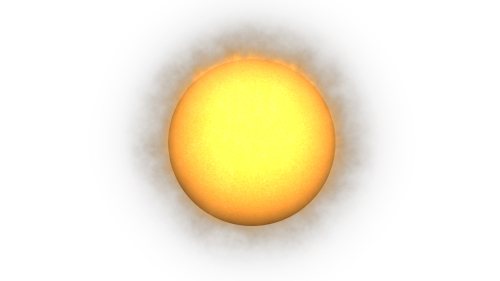 |
(NASA) |
"The fact that we still see a positive imbalance despite the prolonged solar minimum isn't a surprise given what we've learned about the climate system, but it's worth noting because this provides unequivocal evidence that the sun is not the dominant driver of global warming," Hansen said.
According to calculations conducted by Hansen and his colleagues, the 0.58 watts per square meter imbalance implies that carbon dioxide levels need to be reduced to about 350 parts per million to restore the energy budget to equilibrium. The most recent measurements show that carbon dioxide levels are currently 392 parts per million and scientists expect that concentration to continue to rise in the future.
Climate scientists have been refining calculations of Earth's energy imbalance for many years, but this newest estimate is an improvement over previous attempts because the scientists had access to better measurements of ocean temperature than researchers have had in the past.
The improved measurements came from free-floating instruments that directly monitor the temperature, pressure and salinity of the upper ocean to a depth of 2,000 meters (6,560 feet). The network of instruments, known collectively as Argo, has grown dramatically in recent years since researchers first began deploying the floats a decade ago. Today, more than 3,400 Argo floats actively take measurements and provide data to the public, mostly within 24 hours.
Hansen's analysis of the information collected by Argo, along with other ground-based and satellite data, show the upper ocean has absorbed 71 percent of the excess energy and the Southern Ocean, where there are few Argo floats, has absorbed 12 percent. The abyssal zone of the ocean, between about 3,000 and 6,000 meters (9,800 and 20,000 feet) below the surface, absorbed five percent, while ice absorbed eight percent and land four percent.
The updated energy imbalance calculation has important implications for climate modeling. Its value, which is slightly lower than previous estimates, suggests that most climate models overestimate how readily heat mixes deeply into the ocean and significantly underestimates the cooling effect of small airborne particles called aerosols, which along with greenhouse gases and solar irradiance are critical factors in energy imbalance calculations.
"Climate models simulate observed changes in global temperatures quite accurately, so if the models mix heat into the deep ocean too aggressively, it follows that they underestimate the magnitude of the aerosol cooling effect," Hansen said.
Aerosols, which can either warm or cool the atmosphere depending on their composition and how they interact with clouds, are thought to have a net cooling effect. But estimates of their overall impact on climate are quite uncertain given how difficult it is to measure the distribution of the particles on a broad scale. The new study suggests that the overall cooling effect from aerosols could be about twice as strong as current climate models suggest, largely because few models account for how the particles affect clouds.
"Unfortunately, aerosols remain poorly measured from space," said Michael Mishchenko, a scientist also based at GISS and the project scientist for Glory, a satellite mission designed to measure aerosols in unprecedented detail that was lost after a launch failure in early 2011. "We must have a much better understanding of the global distribution of detailed aerosol properties in order to perfect calculations of Earth's energy imbalance," said Mishchenko.
<한글기사>
`실종' 우주 에너지 지구에 남아있다
2년 전 "지구의 에너지가 사라지고 있다"는 가설이 제기돼 많 은 과학자들의 관심을 끌었지만 최신 연구 결과 사실이 아닌 것으로 나타났다고 지 구과학 웹사이트 아워 어메이징 플래닛과 사이언스 데일리가 30일 보도했다.
지구의 주요 에너지 공급원은 쉴 새 없이 뜨거운 열을 쏟아 붓는 태양이다. 태 양 에너지는 지구의 기상 시스템을 가동시켜 생명체가 살 수 있는 따뜻한 온도를 유 지시키고 식물의 광합성 작용을 일으킨다.
그러나 태양 에너지 전량이 지구에 흡수되는 것은 아니고 일부는 반사돼 우주로 되돌아간다.
미항공우주국(NASA) 과학자들은 대기권에서 흡수되는 태양 에너지의 양과 우주 로 되돌아가는 에너지의 양을 비교한 결과 대부분의 에너지가 바다 속에 열(熱)로
남아 있음을 밝혀냈다고 네이처 지오사이언스지 최신호에 발표했다.
이들은 지난 2001~2010년 사이 NASA의 위성 CERES(구름 및 지구 복사에너지 시 스템 실험)가 수집한 대기권 최상층부의 순(純)복사량 자료를 분석해 세 군데의 대 양 센서 자료와 대조한 결과 대체로 안정을 유지하고 있음을 발견했다.
연구진은 앞서 미대기연구센터(NCAR) 연구진이 `에너지 실종'설을 제기할 때 내 세웠던 오차범위보다 실제 오차범위가 크다고 지적했다.
NCAR 연구진은 지구의 열을 위성으로 측정한 결과와 바다의 온도 상승폭 측정치 를 비교한 결과 꾸준히 진행되던 지구 온도 상승세가 2004~2008년 사이에 둔화한 것 으로 나타났다면서 지구에서 에너지가 사라지고 있다는 가설을 제기했었다.
NASA 과학자들은 그러나 이는 NCAR 연구진의 측정 방식이 2003년 바뀐데서 온 결과라고 지적하고 신ㆍ구 방식의 오차한계를 모두 적용한 결과 차이가 "통계적으로 의미있는 수준이 아니다"라는 결론을 내렸다고 밝혔다.
이들은 남은 에너지 가운데 10% 미만이 육지와 대기를 데우고 눈과 얼음을 녹이 며 나머지는 바다 속에 열로 갇혀 있다고 말했다.
연구진은 전세계 바다에 띄운 3천여개의 부유 측정장비로 수집한 수심 2천m 범 위까지의 자료를 분석한 결과 "지구는 1㎡당 0.5와트 꼴로 바다에 열을 축적하고 있 으며 열 축적량이 줄어들지 않는 것으로 나타났다"고 말했다. (연합뉴스)







![[Today’s K-pop] Blackpink’s Jennie, Lisa invited to Coachella as solo acts](http://res.heraldm.com/phpwas/restmb_idxmake.php?idx=644&simg=/content/image/2024/11/21/20241121050099_0.jpg)